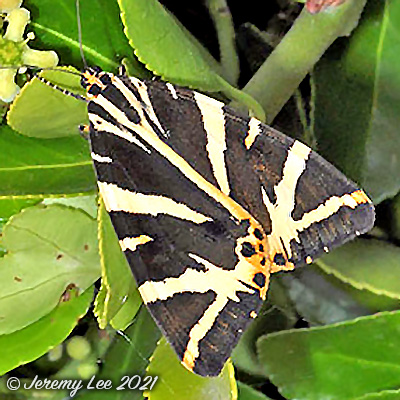
 |
|
Scientific Classifications explained » Amphibians » Ants » Aphids » Bees » Beetles » Birds » Bugs » Butterflies » Caterpillars » Damselflies » Dragonflies » Earwigs » Flies » Frog/Leafhoppers » Fungi » Galls » Grasshoppers » Harvestmen » Hoverflies » Lacewings » Ladybirds » Leaf Mines » Lichens » Mammals » Millipedes » Mosses » Moths » Sawflies » Slugs » Snails » Spiders » Trees » Wasps » Wild Flowers » Woodlice |
UK Nature > Moths > Euplagia quadripunctaria

Scientific Name: Euplagia quadripunctaria Common Name: Jersey Tiger Moth Euplagia quadripunctaria, more commonly known as the Jersey Tiger Moth, is predominently black with bold cream stripes. The underwings are bright orange with black patches and wingspan is approximately 60mm. Originally only found in the Channel Isles, it is now fairly common on the Isle of Wight and in Devon and Dorset. London is reporting more and more sightings and the trend (possibly due to climate change) is for it to move further north across the UK. On the wing from June to September, it is usually seen in gardens, woodland edges and waste ground. Jersey Tigers fly by day in sunny weather and settle amongst vegetation when it's dull. They also fly at night and can be readily attracted to light. The caterpillars of Jersey Tigers are black with a wide yellow stripe along the back and cream spots along the sides and a black head, each body segment has a tuft of orange-brown hair. They feed on nettles, dandelion and plantains. |
|

https://www.uknature.co.uk is a website dedicated to showing the immense diversity of UK nature and wildlife. Our vast range of habitats, from lowland arable to snow covered mountains, from storm-ravaged coastlines to peaceful inland freshwater lakes and rivers, from dry, sandy heaths to deciduous and coniferous forests, all these habitats contribute to the abundance of UK nature. We have wild birds in huge numbers either residing or visiting our shores (597 recorded species as at July 2013) and we must also not forget the humble back garden with its grass lawns, flower beds filled with nectar rich flowers, shrubs and trees, all designed to attract huge numbers of insects such as bees, moths, butterflies and hoverflies; and finally the small ponds which provide safe havens for frogs, toads, newts and even slow worms and grass snakes. www.uknature.co.uk is the showcase for my personal passion, photographing uknature in all its glory. I sincerely hope you all enjoy the fruits of my labours. This site and all images contained therein is © Jeremy Lee 2004 - 2021. All Rights Reserved. Site design by Jeremy Lee. Site development & IT Support by Stuart Lee. |